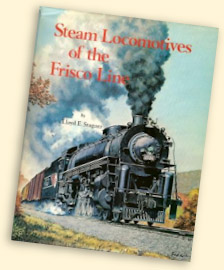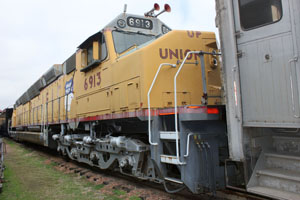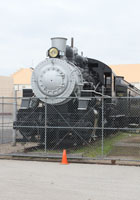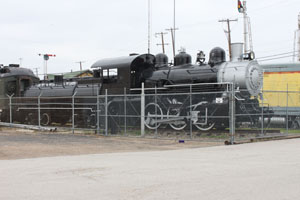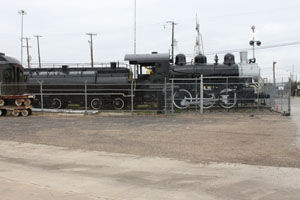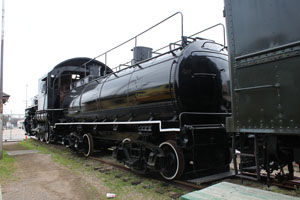

When this page was first published, the Museum of the American Railroad was located at 1105 Washington Street, Fair Park, Dallas, TX, on the north side of Fair Park, site of the 1936 Texas Centennial Exhibition. However, at that time the museum was in dispute with the City of Dallas over its occupation of the site pending a planned move to Frisco, TX. The process of moving began in late 2012 and it is best to check the musuem website before planning a visit: www.museumoftheamericanrailroad.org.
In its nearly half century existence, the museum has amassed an interesting collection, with over thirty pieces of railroad equipment, including steam, diesel and electric locomotives, as well as historic structures, signals and other rolling stock. Perhaps as expected, much of this relates to the South Western US. On the other hand, the site at Washington Street was somewhat cramped, with the tracks laid quite closely and much of the equipment coupled together, which made getting good photos difficult.
The proposed development in Frisco should add much more space and, at least in design, looks like an exciting opportunity for the museum and a future pleasure for railroad enthusiasts!

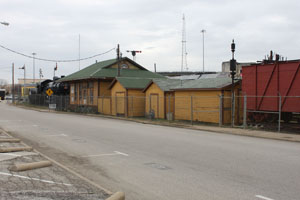
The ticket office, shop and entrance to the museum are located in the restored 1903 Dallas passenger depot of the Houston & Texas Central Railroad and Texas & New Orleans Railroad.

The Houston & Texas Central was the first railroad to reach Dallas in 1872. The Texas & New Orleans arrived in 1903 by which time both railroads were part of the Southern Pacific system.
The depot served passengers until 1918, when it became the Yardmaster's office. In 1963, it was relocated 1¼ miles from its original site to Fair Park with inauguration of the Age of Steam Railroad Museum, precursor to the Museum of the American Railroad.


#1625 was built by Alco in 1918. It is one of about twelve hundred Decapod
(2-10-0) locomotives built for the Imperial Russian State Railway by US builders between 1917 and 1918.
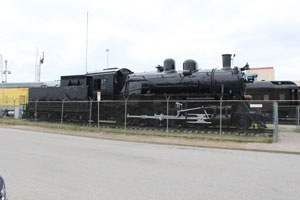
Over two hundred were never delivered because of the Russian Revolution, and were transferred to the USRA. SLSF acquired #1625 in 1920 along with nineteen other "orphaned" Decapods.
Over the years, they were fitted with stokers and a single thermic syphon. Built for Russia's 5' gauge, the locomotives were not regauged for the US 4' 8½" standard gauge. Although the front pilot was replaced, the drivers were simply fitted with wider tyres.


Unfortunately, the wider tyres meant the drivers could climb over the rail on tight curves but the SLSF considered them good locomotives for work on secondary lines, and they remained in service into the 1950s. They were designed for freight but also hauled passenger services on occasion.
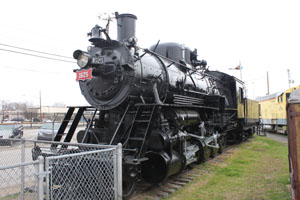

#1625 was one of five SLSF Decapods sold to Eagle-Picher in 1951. Weighing 210,000 lbs, it has 25" x 28" cylinders and 52" drivers. With a 65 sq ft grate, 227 sq ft firebox, total heating surface of 3,189 sq ft, including 579 sq ft superheating, it operated at a boiler pressure of 180 psi delivering 51,490 lbs tractive effort. #1625 retired in 1957 and was donated to the museum in 1964.
All five Eagle-Picher Decapods have survived. SLSF #1621 is on the National Museum of Transportation, St. Louis Yard page of this website, SAL #544, is on the North Carolina Transportation Museum page and SLSF 1632 is on the Belton, Grandview & Kansas City Railroad page.

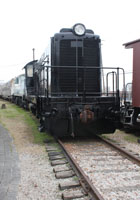
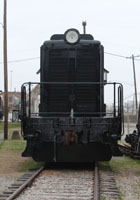
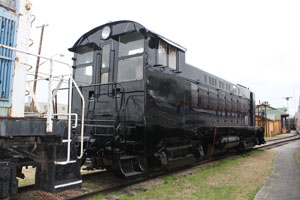
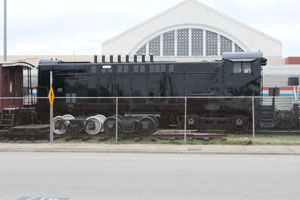
This is one of two Baldwin VO-1000 switchers (#1107 and #1108) delivered to the Colorado & Wyoming Railroad in September 1943 to work at the Colorado Fuel & Iron Works in Pueblo, CO. A third VO-1000, #1109, was delivered in December 1943.
#1107 was later sold to the Western Railroad Company and operated at its New Braunfels, TX, rock quarry. It was donated to the museum in 1990 by the Parker-Lafarge Corporation.
The VO-1000 is 48' 10" long and weighs 244,500 lbs. It has a 1,000 hp eight cylinder De Lavergne VO 6c prime mover, which drives a Westinghouse WE480 generator to power four Westinghouse WE362 traction motors, one on each axle. With a top speed of 60 mph, it delivers 34,000 lbs continuous tractive effort at 10.8 mph.
Five hundred and forty-eight VO-1000s were built by Baldwin between 1939 and 1946, all for US railroads, including twenty-six for the US Army and forty for the Navy. Several railroads repowered and remodelled their
VO-1000s, not always successfully. Only seven examples have survived. You can see CTN #32 on the B&O Museum Yard & Car Shop page of this website.


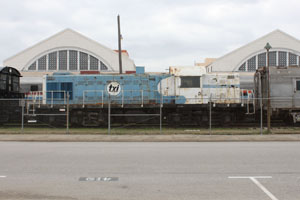
TXIX #8000 was one of two Alco built
1,000 hp RS-1 switchers delivered to the New York Susquehanna & Western Railroad in 1942. Part of the first batch of thirteen RS-1s destined for five US Railroads by Alco, all thirteen were subsequently requisitioned by the US Army, returned to Alco and rebuilt as six axle RSD-1 units (USA #8000-#8012) for use on the Trans Iranian Railroad to supply the USSR during WWII.
During its war service, #8000 hauled materials to Stalingrad. It then returned to the US and was sold as military surplus to TXI Industries. For twenty-five years it worked at the company's Midlothian, TX, concrete plant and was donated to the museum by TXI in 2000.
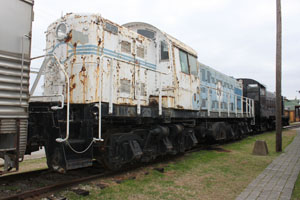

The RSD-1 is 54' 11" in lenght and weighs 204,000 lbs. Equipped with a V12 4-cycle Model 539T-6L prime mover powering a GE GT553C generator to drive four GE 731 traction motors, it delivered 34,000 lbs tractive effort at 8 mph with a top speed of 60 mph.
Another one hundred and forty-four
RSD-1s were built during the war, seventy of which were shipped to the Soviet
Union, and a further six were built in 1946 for Ferrocarriles Nacionales de México. You can see a number of preserved RS-1s on this website, as well as USA RSD-1 #8651 on the National Railroad Museum page and ARR RSD-1 #1034 on the Railroad Museum of Pennsylvania Yard page.

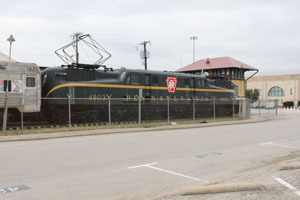
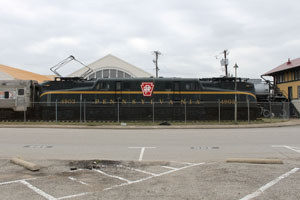
#4903 is one of one hundred and thirty-nine GG1s built by General Electric (fifteen) and the Pennsylvania Railroad (one hundred and twenty-four) between 1934 and 1943, excluding #4800, the prototype. They were designed to haul
12-14 car passenger trains on the Pennsy's electrified Northeast Corridor between Harrisburg and Philadelphia, PA, New York City, NY, and Washington, DC.
The GG1 drew power from a 25 Hertz 11,000 Volt AC current transmitted from overhead electrical wires through a pantograph. Twelve 385 hp GEA-627-A1 traction motors drove six 57" driving wheels on three axles using a quill drive, easily producing the desired speeds of 100 mph plus.
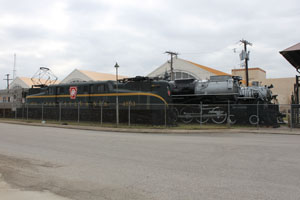
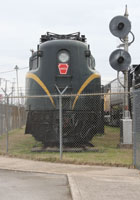

As Penn Central #4903, along with PC #4901, it pulled Senator Robert F. Kennedy's funeral train from New York, NY, to Washington, DC, on 8th June 1968. When absorbed into Amtrak, it was renumbered AMTK #4906.
#4903 was traded from the National New York Central Museum in Elkhart, IN, in 1980 and has been restored to its original PRR livery. You can see the GG1 prototype, #4800 "Old Rivets", on the Railroad Museum of Pennsylvania Yard page of this website, #4919 on the Virginia Museum of Transportation page, #4890 on the National Railroad Museum, #4882 on the National New York Central Museum and #4927 on the Illinois Railway Museum Train Shed page.

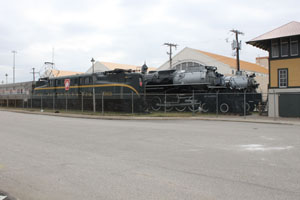
Above, Union Pacific Big Boy #4018 flanked by PRR #4903 and SLSF #4501. On the right is Gulf, Colorado & Santa Fe Railway Interlocking Tower #19 built in 1903. It controlled intersecting rails of the CG&SF and MKT systems in south Dallas for ninety years before being decommissioned.
It then stood idle for two years until moved to Fair Park in 1996.
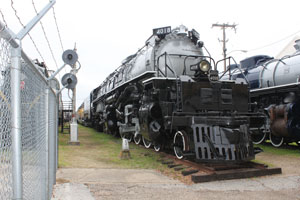
#4018 is one of the first group of twenty
4-8-8-4 Big Boys built by Alco in 1941 (#4000-#4019) designated "Class 1".
A further five Big Boys (#4020-#4024)
were built by Alco to the same specification in 1944. These were designated "Class 2".
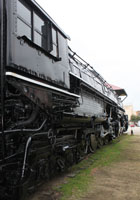
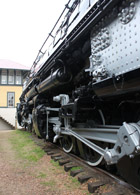
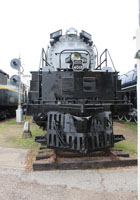
Big Boys were built to haul high tonnage freight.
They mainly operated between Cheyenne and Laramie, WY.
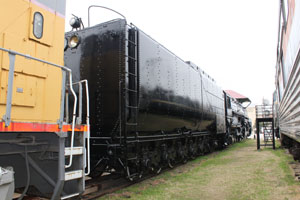
#4018 last operated in October 1957. It then went into storage with several other steam locomotives at Union Pacific's Cheyenne, WY, shops but was not officially retired until 1962.
It was donated to the museum by Union Pacific in 1964 and arrived on site in 1965 having travelled from Wyoming to Kansas City and then south via AT&SF trackage to Dallas.
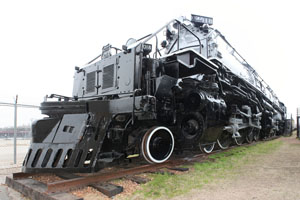
Eight Big Boys have been preserved.
You can see more on the Cheyenne Big Boy page of this website, Steamtown, Forney Museum, National Museum of Transportation, St. Louis Yard,Southern California RLHS, National Railroad Museum and Kenefick Park pages.

The DDA40Xs hauled fast freight over most of the UP system until high maintenance costs forced their eventual retirement in the mid 1980s.
#6913 was built at a cost of $551,168 and delivered to the Union Pacific in 1969. It was retired in 1986, by which time it had run up 2 million miles of service. It was donated to the museum in 1986 by the Union Pacific.
#6913 is one of thirteen DDA40X diesel-electric locomotives built by EMD for the Union Pacific to have survived.
A total of forty-seven were delivered (#6900-#6946) between 1969 and 1971, the largest and most powerful single diesel units ever built. They were named "Centennials" in honour of the driving of the Golden Spike at Promontory, UT, one hundred years previously in 1869.
The DDA40X is 98' 5" long and weighs 521,980 lbs. It has two 16 cylinder 645E3A prime movers each powering a GM AR12 generator to drive eight GM D77 traction motors. It developed starting tractive effort of 113,940 lbs at 25%, 103,000 lbs continuous tractive effort at 12 mph and 19,800 lbs at its top speed of 90mph.

You can seeDDA40X #6900 on the Kenefick Park page of this website, #6915 on the Southern California Chapter RLHS page, #6916 on the Ogden Union Station page, #6922 on the UP Challenger page, #6930 on the Illinois Railway Museum Yard and #6936 on the Cheyenne Roundhouse pages.

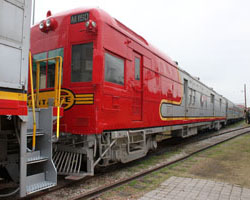
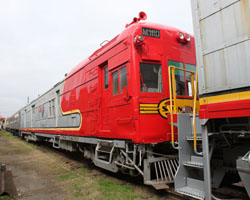
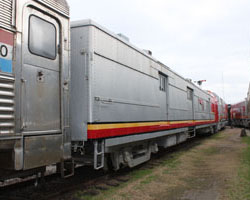
Built by the Brill Motorcar Co., in Philadelphia, PA, in 1931, M-160 as a 535 hp gas-electric combined baggage/motor car.
It was generally coupled to one or two passenger coaches when in service.
Originally painted with a zebra-striped front,
M-160 was eventually repainted in the renowned red, yellow and silver Santa Fe "Warbonnet" scheme. It underwent major
rebuilds in 1948 and 1952, when it was fitted with a diesel engine and components from AT&SF's first E-1 passenger locomotive.
M-160 spent much of its service life on AT&SF's rural branch lines, initially between
Amarillo, TX, and Carlsbad, NM. It later ran on the Wichita, KS, to San Angelo, TX, route. Its last service run was between Carlsbad and Clovis, NM, on trains #25 and #26, The Cavern.
Left, M-160 from the rear, showing the "blind end". Also visible on the flank of the coach is the AT&SF "Indian Head" drum head logo
M-160 was retired in
1966 and went into storage at Clovis, NM, until it was donated to the museum in 1969, along with ATSF round-end chair observation car #3197.


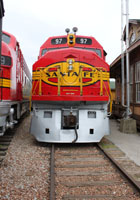
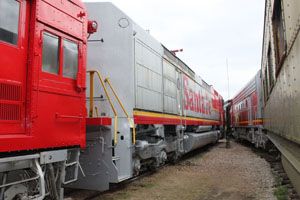
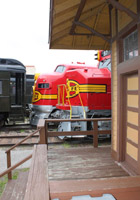
The FP45 was designed by EMD specifically for the AT&SF, which did not want its prestigious Super Chief, El Capitan and other "varnish" passenger trains pulled by freight-style hood-unit locomotives with external walkways. The AT&SF preferred a cowl unit, and this cab design has been used on many subsequent units produced by EMD and GE.
The FP45 was basically an SDP45 under a cowl. Like the SDP45, it was powered by a V20 645E3 prime mover, which powered a GM D32 generator to drive four GM D77 traction motors. Weighing 360,000 lbs and 72' 4" long, only fourteen were built from 1967 to 1968, nine for the AT&SF (#100-#108) and five for the Milwaukee Road (#1-#5).
When Amtrak took over passenger services in 1971, the AT&SF FP45s were reassigned to fast freight service, repainted in the standard blue and yellow freight scheme and renumbered. Eventually, the units were repainted in a modified AT&SF "Warbonnet" and renumbered. #97 was the last in service and was donated to the museum by BNSF in 1999.

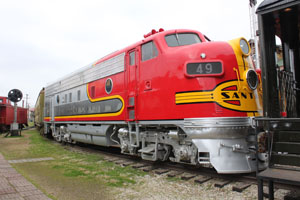

#49 is a 1,500 hp F7 diesel-electric locomotive produced by General Motors Diesel of Montreal, an EMD subsidiary, for Canadian National Railways. It was purchased by the museum in 2000 and repainted in the Santa Fe "Warbonnet".
Two thousand, three hundred and sixty-six F7 A units and one thousand, four hundred and eighty-three cabless B units were built between 1949 and 1953 by GMD and EMD. The F7 was promoted as a freight-hauling unit, but was also used in passenger service.
The AT&SF rostered two hundred and fifteen F7 A units and two hundred and forty-seven F7 B units. F7s #37-#47 hauled trains such as the Super Chief and El Capitan.


Above, Southwestern Portland Cement Co., Fairbanks Morse switcher H-12-44 #115. It was delivered to the Southern Pacific in 1956 as #1581 (later renumbered #2379), and was one of sixty-one of these diesels owned by the SP. Most of them operated in the San Francisco, CA, area.
All SP's H-12-44s were retired by 1975, when #2379 was sold to Southwestern Portland Cement. It was bought by the museum in 1993 and is now the museum's main switcher.
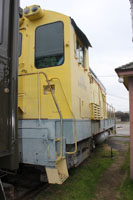

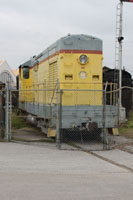
Fairbanks Morse, developed a diesel engine used on much of the US Navy's WWII submarine fleet. With two pistons in each cylinder, it generated nearly twice as much power from the same number of cylinders as other engines.
Taking advantage of post-war railroad dieselisation, the company introduced what was then the most powerful engine available in a diesel, but the units were difficult to maintain and only three hundred and thirty four H-12-44s were built from 1950 to 1961.

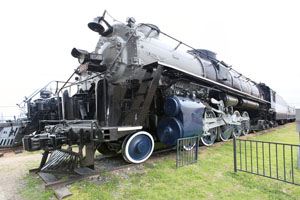
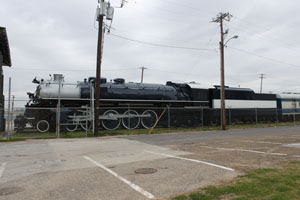
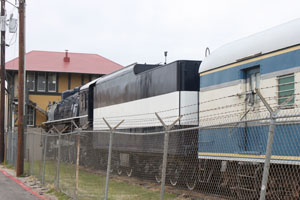
#4501 is one of three Northern (4-8-4)
type locomotives designed to haul
the St. Louis-San Francisco's crack overnight Meteor passenger service from Oklahoma City via Tulsa, OK, to St. Louis, MO. The other two locomotives on the service were #4500 and #4502.
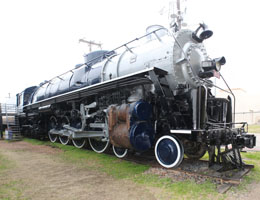
The three 4500 class Meteor locomotives were built by Baldwin and delivered in 1942 painted in zephyr blue, white and grey, with "Meteor" across the tender in distinctive red lettering. When I visited, #4501 seemed to be part way through a paint job - there was no lettering on the tender and no number on the cab or sand dome.
The three locomotives also hauled the Texas Special but, when it and the Meteor were dieselised in 1947, they were re-painted in SLSF's standard black with gold striping and lettering, and assigned to other passenger trains such as the General Wood and Will Rogers.
SLFS bought twenty-five of these
4-8-4s from Baldwin. The first three were oil burners, but #4503-#4514 also delivered in 1942 and #4515-#4524 delivered in 1943 were coal burners intended for fast freight service, although they also hauled some passenger trains.
They were the last steam locomotives purchased by SLSF.
#4501 weighs 45,400 lbs and has 74" drivers and 28" x 31" cylinders. With a 544 sq ft firebox, 88 sq ft grate area, combined heating area of 6,296 sq ft, including 1,530 sq ft superheating, it operated at a boiler pressure of 255 psi, delivering 71,200 lbs tractive effort.
Below, a composite view of #4501's backhead.
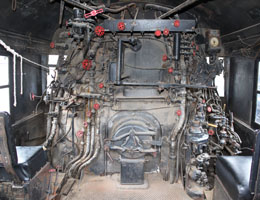
Several 4500s were rebuilt and stored near the end of SLSF steam in 1952 behind the Lindenwood Roundhouse in St Louis, MO, until either scrapped or donated for display. #4501 was donated to the museum by SLSF in 1964.
Three other 4500s survive: #4500 has been restored and moved to a new site at Route 66 Park in Tulsa, OK. You can see it on the SLSF #4500 page of this website, #4516 in the State Fairgrounds, Sedalia, MO, is on the SLSF #4516 page and #4524, the last of the 4500 class, in Grant Beach Park, Springfield, MO, on the SLSF #4524 page.
Related Links:
Museum of the American Railroad
Santa Fe Railway Historical & Modeling Society
Frisco History Page
Send a comment or query, or request permission to re-use an image.
Lloyd Stagner's Steam Locomotives of the Frisco Line was published by Pruett Publishing Company, Boulder, CO, in 1976 (click on the cover to search for this book on Bookfinder.com).
